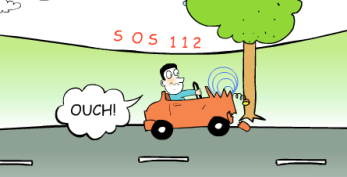The European Parliament has approved the requirement for eCall by March 2018. The implications of the ruling will impact automotive and telecommunications players along with the potential for new options to save lives.
Let’s start with an overview of what eCall is: A European Union initiative to bring assistance to motorists in the event of a car crash even if they are unable to contact the emergency services on their own. The projections are that the emergency services response time will be reduced by 50% outside of cities and 60% within them by the implementation of this functionality. Someone who witnesses an accident can also contact emergency services by pushing an eCall button inside their vehicle. For those who worry about privacy – the system “sleeps” until a collision occurs, so there is no capability for vehicle tracking. This function is free of charge to the driver and will be required in all new vehicles by the 2018 deadline.
When the crash sensors in the car identify a collision, the eCall SIM will establish a connection with the appropriate MNO to dial emergency services. The only information provided will be the location of the collision, time of occurrence, type of fuel used and auto make and model. No personal data is tracked and shared. The cost to the auto OEM to equip a car with this functionality is around $113.
But Russia will beat the EU in implementing such a solution. Beginning in 2016 all commercial freight and transport vehicles over 2.5 tons must have ERA-GLONASS – the Russian Federation’s version of eCall – enabled. By 2017 all transportation vehicles regardless of weight must be compliant. Think of GLONASS as Russia’s version of GPS, although it uses different frequencies. In this region the response times are projected to decrease by 30% and save 4,000 lives per year. Find out more.
With all of this said, there is the discussion around how the connection occurs. Is it directly from the vehicle or can the smartphone play a role, and is there a SIM that is eCall-only enabled or can other functions be supported? If the latter, dormancy does not fly. I believe the discussion is leaning toward the vehicle, not the smartphone, and an embedded SIM or embedded universal integrated circuit card. Given that Qualcomm has been participating in the EU discussions, there’s one company that likely stands to gain from this initiative.
There’s also a lot of talk about the opportunity to link the eCall with personal health data so that the emergency service crews know who they will find in the crash and any preexisting health issues. This opens a whole new can worms on privacy and would definitely require an opt-in. But on the positive side, I can see more lives being saved through better preparation for treatment based on this added knowledge.
And of course the conspiracy theorists are out in force on this one, saying that this is really a master plan for governments and foreign entities to track what the EU drivers are up to. I’ll just leave it with this: Maybe some people have overactive imaginations or too much time on their hands.
Like what you read? Follow me on twitter!
Claudia Bacco, Managing Director – EMEA for RCR Wireless News, has spent her entire career in telecom, IT and security. Having experience as an operator, software and hardware vendor and as a well-known industry analyst, she has many opinions on the market. She’ll be sharing those opinions along with ongoing trend analysis for RCR Wireless News.

